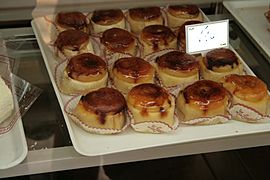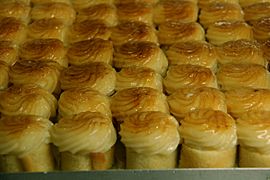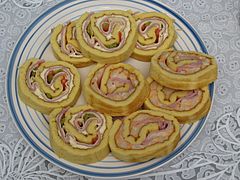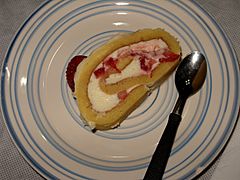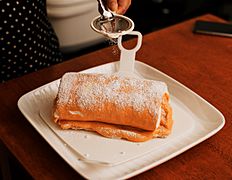Pionono facts for kids
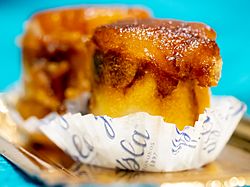 |
|
| Type | Pastry |
|---|---|
| Place of origin | Spain |
Pionono is a tasty treat found in many places! It can be a sweet or savory pastry. You can find different kinds of piononos in Granada, Spain, the Caribbean islands, South America, and the Philippines. This yummy food got its name from Pope Pius IX. In Spanish, his name was "Pío Nono".
Contents
Pionono Around the World
Pionono in Spain
In Spain, piononos are small pastries. They are a special tradition in Santa Fe, a town near the city of Granada. A Spanish pionono has two main parts. First, there's a thin layer of pastry rolled into a cylinder. This pastry is soaked in different sweet syrups. This makes the pionono very moist and delicious! On top, it has a crown of toasted cream. People usually eat this small treat in just one or two bites.
The most famous place that makes piononos in Granada is "Pastelerías Casa Isla". They have many shops all over the city.
Pionono in South America and Cuba
In many South American countries, like Argentina, Uruguay, Paraguay, Venezuela, Colombia, Peru, and also in Cuba, piononos are made differently. Here, the dough is made from flour, eggs, and sugar. This dough is baked into a thin, flat sheet.
After baking, the sheet is rolled up with a yummy filling inside. A popular sweet filling is dulce de leche, sometimes with walnuts or fruits like strawberries and chantilly cream. For savory piononos, people might use cured ham, cheese, tomato, and mayonnaise. You can also find them filled with savory salads, like ham salad with asparagus and lettuce, chicken salad, or even tuna. In Cuba and some other countries, this rolled pastry is also called "Brazo de Gitano" or "Brazo Gitano".
Pionono in Puerto Rico
In Puerto Rico, piononos are unique because they use yellow, sweet plantains as the "bread" part. These plantains are wrapped around a savory filling. The most common filling is a meat mixture called picadillo, or sometimes seafood with cheese. The whole pionono "sandwich" is then dipped in a batter made from flour and eggs. Finally, it's deep-fried until golden and crispy!
Pionono in the Philippines
In the Philippines, the name for this pastry is usually spelled pianono. It is a type of rolled sponge cake, very similar to a jelly roll. It starts with a thin layer of pastry made from eggs, sugar, and sifted flour, baked flat. Once it cools down, jelly or other fillings are spread over the pastry. Then, it's carefully rolled up from one end to the other.
The most traditional filling for a Filipino pianono is simply sugar and butter (or margarine). This is similar to other Filipino sponge cakes called mamón. However, modern pianonos often have frosting on top and can be filled with many different tasty things.
Gallery
-
Sliced savory Argentine pionono, with ham, cheese, Salsa golf, and vegetables
-
Sweet Argentine piononos with dulce de leche
See also
 In Spanish: Pionono para niños
In Spanish: Pionono para niños


